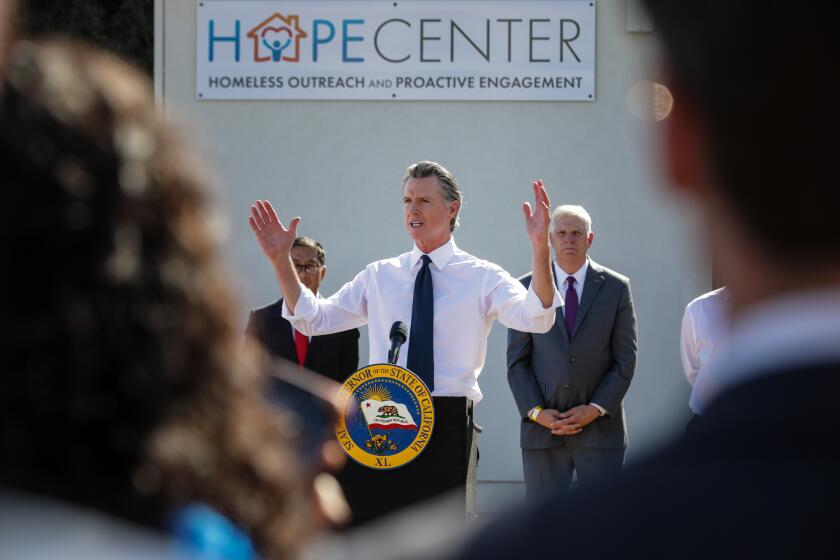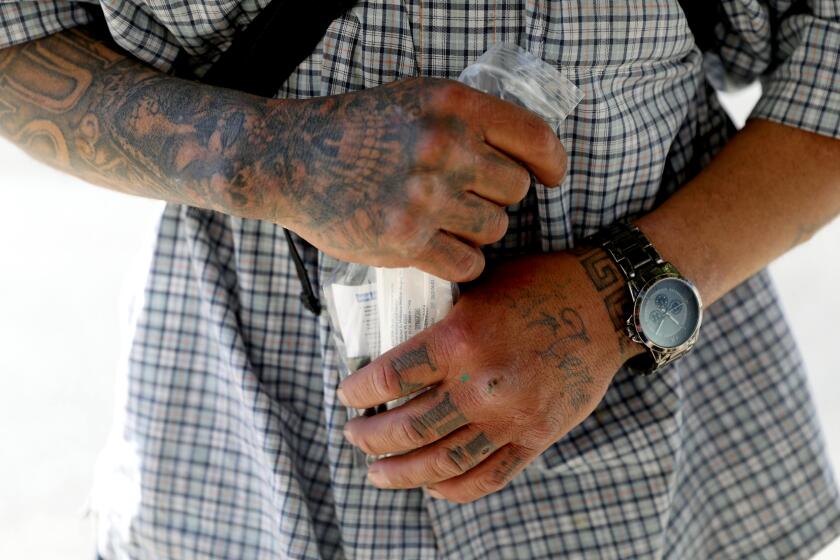Newsom says the state is on track to cut unsheltered homelessness by 15%

- Share via
After criticizing local officials for failing to adequately address the pernicious problem of homelessness in California, Gov. Gavin Newsom on Thursday announced that the state is on track to cut the number of unsheltered people by an ambitious 15% in two years and vowed to provide 1,200 tiny homes to help achieve that goal.
The announcement kicked off Newsom’s atypical State of the State tour around California, which replaces a speech outlining his political agenda that governors traditionally deliver annually to the state Legislature at the Capitol. Newsom, who dislikes reading off teleprompters because of his dyslexia, is instead taking his speech on the road this year and intends to make policy announcements at stops in Sacramento, the San Francisco Bay Area, Los Angeles and San Diego through the weekend.
Gov. Gavin Newsom will announce that he is rejecting local homeless action plans from all 75 state applicants seeking hundreds of millions in funding, demanding higher goals to reduce the number of unsheltered people, and those finding permanent housing.
Three years ago and weeks before the COVID-19 pandemic forced a state of emergency, Newsom dedicated his entire address to homelessness and his commitment to ending it. Newsom called the crisis a disgrace to California and said it was his “calling” to alleviate that human misery.
Since then, the numbers have only increased.
California is now home to more than 171,000 homeless individuals, according to the U.S. Department of Housing and Urban Development, a 6.2% increase since 2020. Roughly 67%, or more than 115,000 people, are unsheltered, meaning that they’re living outside. That’s despite Newsom’s attention to the issue, the roughly $15 billion he’s dedicated to the problem since the start of the pandemic, and new housing programs that have sheltered thousands of Californians.
During his first tour stop in Sacramento, Newsom acknowledged “how angry we are as Californians about what’s going on in the streets and sidewalks in our state.”
But he said the state has made “progress” on ambitions to solve its greatest challenge, starting with the goal to reduce the most visible homelessness population by 15%.
“It’s a new day,” he said. “New energy demands new expectations, new results.”
In the fall, Newsom cracked down on what he’s called a lack of accountability by local governments to aggressively tackle the problem and requested greater urgency on homelessness.
To start, he symbolically tossed out the plans that cities and counties submitted to receive funding from the state’s Homeless Housing, Assistance and Prevention (HHAP) Grant Program, which funnels hundreds of millions of dollars each year to local jurisdictions.
The plans vary across communities, depending on homelessness populations and what resources are needed in the area. But taken together, those blueprints had projected a 2% reduction in unsheltered homelessness statewide, a number that Newsom had rebuffed as inadequate.
Newsom halted state funding, convened local officials in Sacramento and asked them to sign a pledge promising more audacious goals for this year’s round of funding. The revised plans project a 15% reduction in unsheltered homelessness by 2025. Though it’s a bolder goal than last year’s, that means tens of thousands of Californians will still be homeless.
The state has allocated nearly $3 billion for HHAP so far, and Newsom has proposed an additional $1 billion in next year’s budget for a fifth round of funding.
From 2012 to 2021, the number of deaths of homeless people in Orange County more than tripled, and accidental overdoses are a leading reason why.
Newsom also said he will provide 1,200 tiny homes to jurisdictions across the state — including 500 in Los Angeles, 150 in San Diego County, 200 in San Jose and 350 in Sacramento — to be used as a temporary housing option for people immediately leaving the streets. He’s tapped the National Guard to help deliver the units.
The tiny homes will add to a list of other housing initiatives Newsom has rolled out during his tenure, including his signature Homekey program, born from the pandemic out of urgency to quickly shelter homeless and vulnerable individuals in hotels and motels.
Homekey has evolved into a sweeping program for the state to acquire and remodel these sites into more permanent and interim housing options for homeless individuals. The program has created 12,774 new homes so far with $2.7 billion in funding, according to the California Business, Consumer Services and Housing Agency.
A similar initiative, Project Roomkey, was created as a temporary shelter option during the pandemic and has since served more than 61,000 people, according to the California Department of Social Services.
“All different types of housing — small homes, motels, hotels, and more — are needed to urgently confront this crisis,” Los Angeles Mayor Karen Bass said in a statement. “This housing will help us bring more people inside, which is what our city needs right now.”
Sacramento Mayor Darrell Steinberg, a strong supporter of Newsom, also said the tiny homes would be a welcome addition to the shelter options for those currently living on the streets.
Steinberg said he’d like to place Sacramento’s share of the tiny homes on excess land at Cal Expo, where the state fair is held each year and where Newsom kicked off his tour and made his announcement against a backdrop of tiny homes lined up in a large exhibit hall.
The model tiny homes were set up with some of the comforts of home, including small desks and bunk beds made up with blankets and teddy bears.
“It’s another really important contribution and investment,” Steinberg said.
Alluding to criticism that 1,200 tiny homes will do little to solve an out-of-control crisis, Newsom said that the state had to “provide more options.” Newsom said the tiny homes will cost about $30 million, to be pulled from a state behavioral health program that funds crisis intervention and treatment options for vulnerable populations, including those experiencing homelessness.
“The urgency of the moment requires that one of the tools, in terms of our strategy, is to immediately address the anxiety … of being able to actually get someone off the street and have a place to go,” he said.
After winning reelection, Gov. Gavin Newsom plans to focus on the implementation of his policies and combatting a GOP narrative about California.
Still, others argued that greater investments were needed to provide permanent housing options and substance use and mental health treatment programs.
“I think housing has to be a part of the solution. But 1,200 tiny homes, when we have 115,000 unsheltered homeless in our state, I think is probably not going to make a huge dent,” said Assemblymember Josh Hoover (R-Folsom). “I think this is another splashy announcement that I’m skeptical will get actual results.”
Citing the lack of “a comprehensive homelessness plan with clear lines of responsibility and accountability,” California counties unveiled a proposal this week to work with the state and cities to develop a blueprint for reducing homelessness.
“Every level of government is doing everything possible to make progress on homelessness,” said Graham Knaus, chief executive of the California State Assn. of Counties. “But it is also true that we don’t have a real system to address homelessness in California and until we do, our progress will always be far more limited than it should be.”
The proposal calls for legislation and regulatory changes that would define the roles of cities and counties in relation to shelters, supportive housing and encampments and, in turn, create more accountability. The association is also seeking ongoing funding to maintain programs, among other policy changes.
“In every major policy area that is a state priority, except homelessness, there’s clarity about who does what and how accountability links to that,” Knaus said. “It’s just not true around homelessness.”
Chione Flegal, executive director of Housing California, also called for “mutual accountability” in solving homelessness.
Flegal’s organizaton is working on legislation this year introduced by Assemblymember Luz Rivas (D-Arleta) to strengthen the HHAP program and ensure funding is tied to tangible results.
“We certainly share the perspective that everybody needs to be taking this seriously and be ramping up what they’re doing,” Flegal said, “and the state is not exempt from that.”
Sacramento bureau chief Laurel Rosenhall and reporter Julia Wick contributed to this report.
More to Read
Sign up for Essential California
The most important California stories and recommendations in your inbox every morning.
You may occasionally receive promotional content from the Los Angeles Times.















